Recent Posts
Winter Water Damage
1/8/2025 (Permalink)
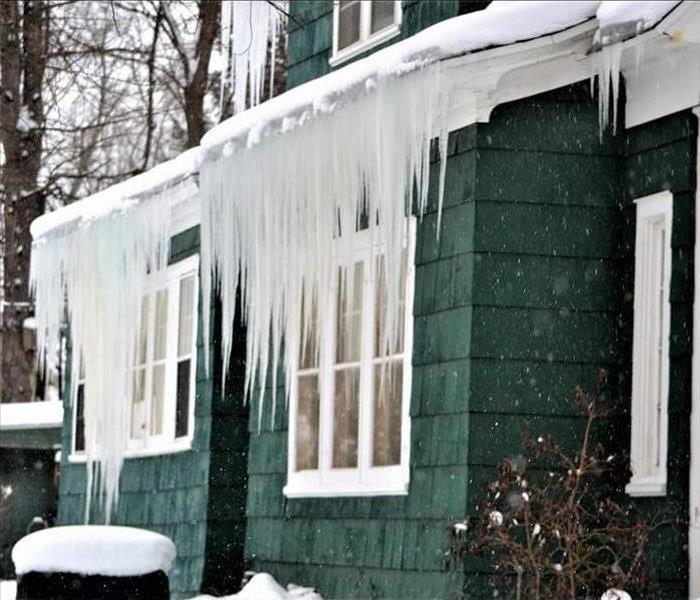 Freezing temperatures, snow, and ice, your home or business could be in jeopardy of water damage.
Freezing temperatures, snow, and ice, your home or business could be in jeopardy of water damage.
Our winters are known to be brutally cold and large amounts of snow are always expected. With below freezing temperatures, snow, and ice, your home or business could be in jeopardy of water damage. It is crucial that you are aware of the hazards and can prepare, prevent or act quickly if faced with winter water damage.
FROZEN PIPES
A frozen pipe can burst at the point where the ice blockage inside the pipe is located, but typically the rupture is caused by the backflow pressure between the water source and the blockage. A burst pipe can cause considerable damage to your property if not addressed quickly.
ICE DAMS
Ice dams can be a major problem during the winter season. They form when heated air melts roof snow downward into water dammed behind still-frozen ice. When the trapped water cannot safely flow or run into the gutter system, it can backflow under the roof ’s shingles and into the structure’s interior areas.
Cold weather, snow, and ice storms can cause severe damage to your home or business. When these types of disasters strike, immediate action is necessary to prevent additional damage to your property. Our team has winter storm experience, expertise, and the resources to remediate damage caused by winter weather. If disaster strikes your home or business during the winter months, know that SERVPRO® has your back.
Flood Preparedness: How to Safeguard Your Home and Family
11/26/2024 (Permalink)
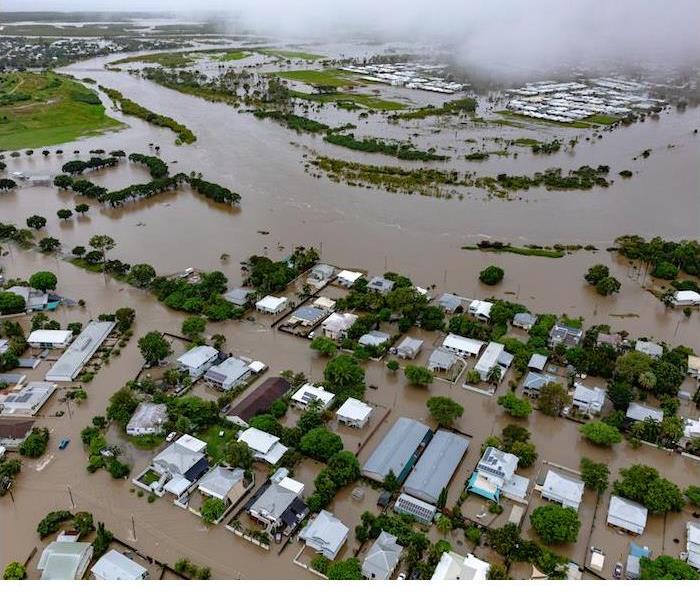 Prepare your home and family for floods.
Prepare your home and family for floods.
Flooding is one of the most common and devastating natural disasters that can impact homes and communities. Whether caused by heavy rainfall, storm surges, or melting snow, floods can result in significant property damage and pose serious risks to personal safety. At SERVPRO®, we understand the importance of being prepared for such emergencies.
Understanding Flood Risks
The first step in flood preparedness is understanding the specific risks in your area. Different regions have varying flood patterns and vulnerabilities, making it crucial to familiarize yourself with local flood zones and history. Check with local government resources or the Federal Emergency Management Agency (FEMA) to learn about your area’s flood risk. Knowing whether your home is located in a flood zone can help you take proactive measures. Additionally, monitor weather forecasts and warnings during heavy rainfall seasons. Staying informed about potential flooding events allows you to react quickly and appropriately.
Equipping your home with flood-resistant features can also mitigate risks. Elevating electrical systems, installing sump pumps, and utilizing flood barriers can significantly reduce the potential for water damage. These preventive measures not only safeguard your property but can also provide peace of mind during heavy storms.
Creating a Flood Emergency Plan
Having a well-thought-out emergency plan is vital for keeping your family safe during a flood. Begin by identifying multiple evacuation routes from your home and local community. Make sure all family members are aware of these routes and practice the plan together. Designate a meeting point outside of your neighborhood where everyone can gather if you become separated.
Prepare an emergency kit that includes essential items such as water, non-perishable food, medications, flashlights, batteries, and first-aid supplies. Don’t forget to include important documents, such as insurance policies and identification, stored in a waterproof container. This kit should be easily accessible and ready to go in case of an emergency.
It’s also wise to stay connected with your community through local alerts and notifications. Many cities have emergency alert systems that provide real-time updates on weather conditions and potential flooding. By being proactive, you can ensure your family is prepared for any situation that may arise.
Taking Action After a Flood
In the unfortunate event that your home does experience flooding, knowing how to respond can significantly reduce damage and promote safety. First, ensure that it’s safe to return to your home before entering. Check for structural damage and avoid contact with floodwaters, as they may contain hazardous materials.
Once you’re safely inside, document the damage for insurance purposes by taking photos and videos. Remove any standing water as quickly as possible, as lingering moisture can lead to mold growth and further damage. SERVPRO specializes in water damage restoration and can help you navigate the recovery process.
Floods can be devastating, but with proper preparation, you can protect your home and loved ones. Start by understanding your flood risks and creating a comprehensive emergency plan. If you ever find yourself facing the aftermath of a flood, remember that SERVPRO can help. Our dedicated team is available 24/7/365 to assist with water damage restoration and ensure your home returns to its pre-flood condition.
Thanksgiving Fire Safety: A Guide for Apartment Dwellers
11/26/2024 (Permalink)
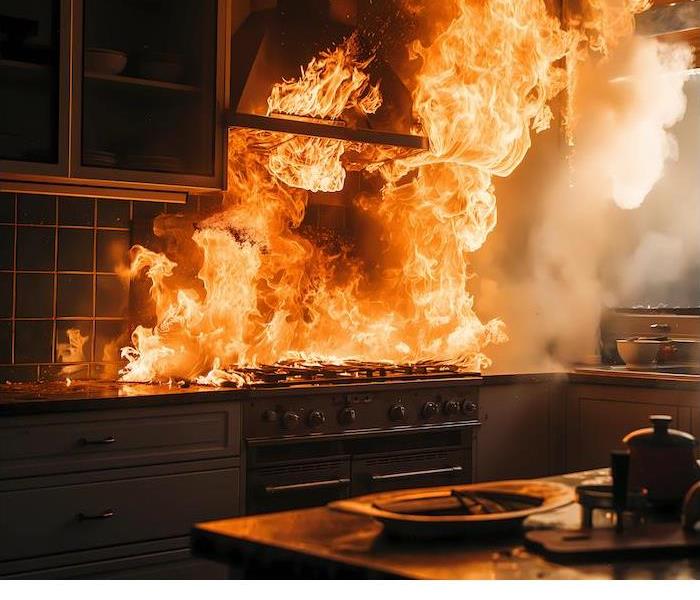 Celebrate Thanksgiving safely—follow fire safety tips, and trust SERVPRO for restoration if needed!
Celebrate Thanksgiving safely—follow fire safety tips, and trust SERVPRO for restoration if needed!
Thanksgiving is a time for families to come together and celebrate with delicious meals, but cooking in an apartment complex or high-rise presents unique challenges and fire hazards. At SERVPRO®, we’re dedicated to helping you enjoy a safe and festive Thanksgiving. Here are essential tips for Thanksgiving fire safety, particularly when preparing your meal in a shared living space. Ensuring a Safe Cooking Environment
When cooking in an apartment, maintaining a safe kitchen environment is crucial. Start by keeping flammable items, such as dish towels, paper products, and packaging materials, away from your stovetop and any heat sources. In a high-rise setting, it’s especially important to remain focused while cooking; distractions can lead to accidents. If you need to step away, even for just a moment, be sure to turn off the heat to prevent any potential fires.
Additionally, check that your smoke detectors are in good working order. Make sure the batteries are fresh, as these alarms are your first line of defense against fire hazards. It’s also wise to familiarize yourself with the fire exits and evacuation routes in your building, as this can help you act quickly in case of an emergency.
Safe Cooking Practices in Shared Spaces
Cooking in a shared kitchen or apartment means being considerate of your neighbors and taking extra precautions. Avoid using deep fryers indoors, as they can create dangerous situations. If you’re considering deep frying a turkey, always do so outdoors, away from the building and any overhanging structures. Make sure your turkey is fully thawed and dry to prevent dangerous oil splattering.
When cooking on the stovetop, never leave pots or pans unattended. If you find yourself distracted, ask a neighbor or family member to keep an eye on your food. It’s also a good idea to use timers to remind yourself when to check on your dishes. In case of a small kitchen fire, know how to use a fire extinguisher, and never attempt to put out a grease fire with water, as it can exacerbate the flames.
Post-Meal Safety Measures
After the Thanksgiving feast, it’s essential to prioritize safety as you clean up. Turn off all cooking appliances and avoid leaving leftovers out at room temperature for more than two hours. Refrigerate leftovers promptly to prevent foodborne illnesses and maintain a clean kitchen environment. When disposing of cooking oil, let it cool completely before transferring it to a sealed container for safe disposal.
As you tidy up, ensure that hot pots and pans are not left unattended. Allow them to cool before washing or storing them. In an apartment complex, it’s important to keep common areas clear and free of any potential fire hazards, so be mindful of clutter in shared spaces.
Thanksgiving is a time for gratitude and connection, but it’s vital to prioritize safety, especially in a high-rise or apartment setting. By following these Thanksgiving fire safety tips, you can enjoy a worry-free holiday with your loved ones. If a fire occurs in your home, remember that SERVPRO is here to assist with fire damage restoration and cleanup.
Urban Fire Safety: Developing an Emergency Plan for Your Business
10/15/2024 (Permalink)
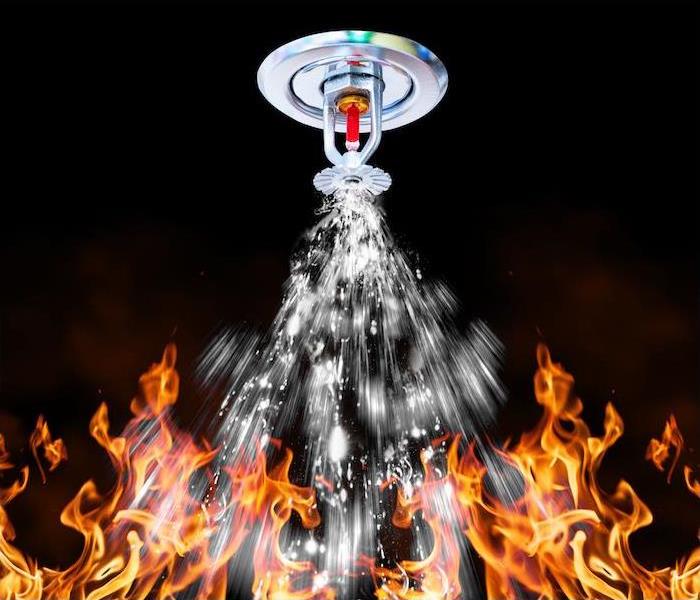 Protect your business with a safety plan!
Protect your business with a safety plan!
In bustling urban areas, fire safety is crucial for protecting both employees and assets. Businesses in larger cities face unique challenges due to their density and diverse environments. A well-structured emergency plan is essential for navigating these risks. Here’s how to create an effective fire safety strategy tailored to urban commercial properties.
Identifying Urban Hazards and Resources
The first step in crafting your fire safety plan is to conduct a comprehensive assessment of potential hazards within your urban business. Urban environments often have unique risks, such as nearby flammable materials, equipment, or high foot traffic areas that can exacerbate fire dangers. Inspect your premises to identify potential hazards, such as overloaded electrical outlets, cluttered exits, and improperly stored materials.
Next, evaluate your fire safety resources. Are fire extinguishers accessible and regularly inspected? Do you have functioning smoke detectors and sprinkler systems? Understanding the specific hazards of your urban setting, along with the resources available to you, will help you tailor your emergency plan effectively.
Establishing Efficient Evacuation Procedures
Once you’ve identified risks and resources, the next step is to create clear evacuation procedures. Designate primary and secondary escape routes that are easily identifiable and accessible for all employees, considering the unique layout of urban buildings. Make sure these routes are well-marked and free of obstacles that could hinder a swift evacuation.
Given the high-density nature of urban settings, consider the diverse needs of your workforce during an evacuation. Implement a buddy system to assist employees who may need extra help. Conduct regular drills to practice these procedures, ensuring that everyone is familiar with the escape routes and confident in their ability to respond.
Fostering a Culture of Training and Communication
An integral part of your fire safety plan is ongoing training and open communication. Schedule regular training sessions that focus on fire prevention strategies, the proper use of fire extinguishers, and emergency reporting protocols. An educated workforce is your strongest asset in mitigating risks and responding effectively to emergencies.
Additionally, establish clear communication channels for employees to report potential hazards or safety concerns. Encourage a culture of vigilance where everyone feels empowered to voice their observations. Proactive communication can help identify and address fire risks before they escalate.
Developing a fire safety plan tailored for your urban business is essential for ensuring the safety of your employees and protecting your assets from the devastating impacts of fire. By identifying hazards, establishing efficient evacuation procedures, and fostering a culture of training and communication, you can create a safer environment within your organization.
Fall Weather Preparedness: Safeguarding Your Home in Autumn
10/2/2024 (Permalink)
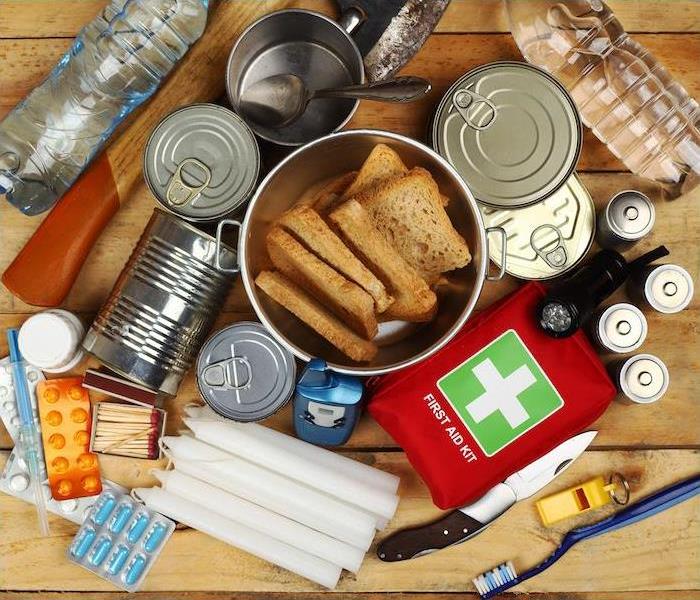 Use these helpful tips to assemble an emergency kit to keep your family safe when disaster strikes.
Use these helpful tips to assemble an emergency kit to keep your family safe when disaster strikes.
As autumn settles around us, the weather shifts from the lingering warmth of summer to the cooler, often unpredictable conditions of fall. While we typically enjoy crisp air and vibrant fall colors, the season can also bring its own set of challenges, including heavy rains, strong winds, and the occasional early snow.
Preparing for these potential weather events is crucial for ensuring the safety and resilience of your home and family. Here’s how you can get ready for fall’s weather variations:
Understanding Fall Weather Challenges
Fall weather is known for its variability. The season often starts with mild temperatures but can quickly change to cooler conditions and unpredictable weather patterns. Heavy rainfall is common, which can lead to flooding, particularly in low-lying areas or those with poor drainage. Additionally, the onset of fall can bring the first signs of snow and icy conditions, which may catch homeowners off guard.
Staying informed about local weather forecasts and any advisories from the National Weather Service is essential. By keeping track of weather updates, you can anticipate changes and take appropriate action to protect your home and family. Understanding the specific risks in Detroit, such as potential flooding and early snow, will help you prepare more effectively.
Creating a Comprehensive Emergency Plan
Having a well-thought-out emergency plan is key to managing fall weather emergencies. Your plan should include communication strategies, evacuation routes, and designated meeting points for your family. Make sure that every family member understands their role and the procedures to follow during various scenarios, such as severe storms, power outages, or flooding.
Regularly review and update your emergency plan to reflect any changes in your family’s needs or circumstances. Additionally, prepare an emergency kit with essentials such as non-perishable food, water, medications, flashlights, and batteries. An accessible and well-stocked emergency kit will help you handle unexpected situations with greater ease and reduce stress during emergencies.
Preparing Your Home for Fall Conditions
To safeguard your home against fall weather, perform routine maintenance and inspections. Begin by checking your roof, gutters, and downspouts for any damage or blockages that could lead to leaks or water damage from heavy rains. Clearing debris from gutters will help ensure proper drainage and prevent flooding.
Additionally, inspect your heating system to ensure it is functioning properly and schedule any necessary maintenance before the colder weather arrives. Consider stocking up on extra heating supplies and preparing for potential power outages. Updating weatherstripping and insulation around windows and doors will also help maintain energy efficiency and comfort. Proactive maintenance and preparedness can help you manage fall’s weather challenges more effectively.
As fall brings its own set of weather considerations, being prepared for emergencies is essential for keeping your home and family safe. By understanding potential weather risks, developing a thorough emergency plan, and ensuring your home is well-maintained, you can navigate the season with greater confidence.
Get Peace of Mind with SERVPRO® Team Miller
9/26/2024 (Permalink)
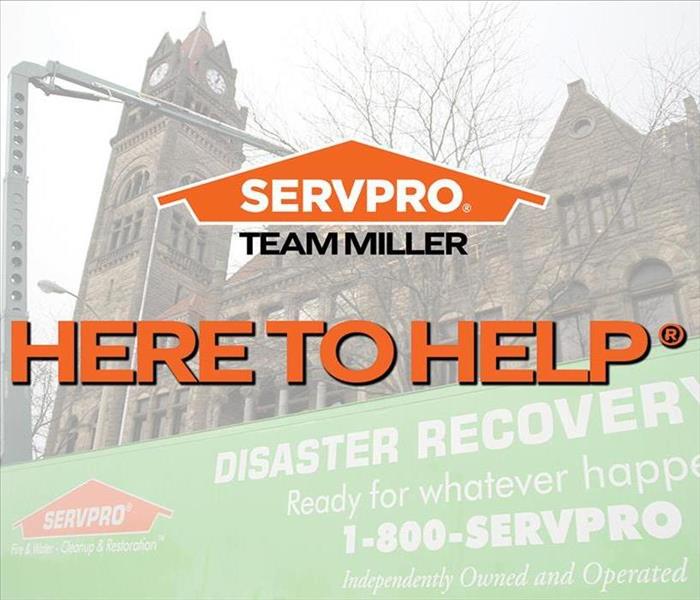 Disasters can catch you off guard, but having a plan in place can make all the difference.
Disasters can catch you off guard, but having a plan in place can make all the difference.
Disasters can catch you off guard, but having a plan in place can make all the difference.
That’s where SERVPRO® Team Miller comes in with our Emergency Ready Profile (ERP). It’s a simple, proactive way to prepare for the unexpected, whether it’s a small water leak or a bigger disaster like a fire or flood.
The ERP isn’t complicated—it’s a plan that helps you know exactly what to do and who to call if something goes wrong. It’s designed to speed up response time and minimize the disruption to your business. Because let’s face it, when disaster strikes, you want things back to normal as quickly as possible.
Establishing SERVPRO as your disaster mitigation and restoration provider gives you access to 50 years experience and a system of more than 2,200 franchises strong. Team Miller has been owned by the Miller Family since 1996, with 24 locations and ongoing aggressive expansion.
We also are one of only 10 designated SERVPRO Extreme Response Teams in North America.
SERVPRO has been named one of America’s Customer Service Champions by USA Today and Plant-A Insights Group with a 4.5-star rating out of 67 industries. We’re honored to have received nearly 520,000 reviews from over 33,000 U.S. customers.
We’re proud to be the only company in the restoration industry included on this prestigious list!
It’s never fun thinking about the “what ifs,” but having a plan can take a load off your shoulders. Let us be your trusted advisor and help you take the steps now to ensure you’re ready for whatever happens.
Steps to Take After Storm Damage: A Guide for Residents
9/16/2024 (Permalink)
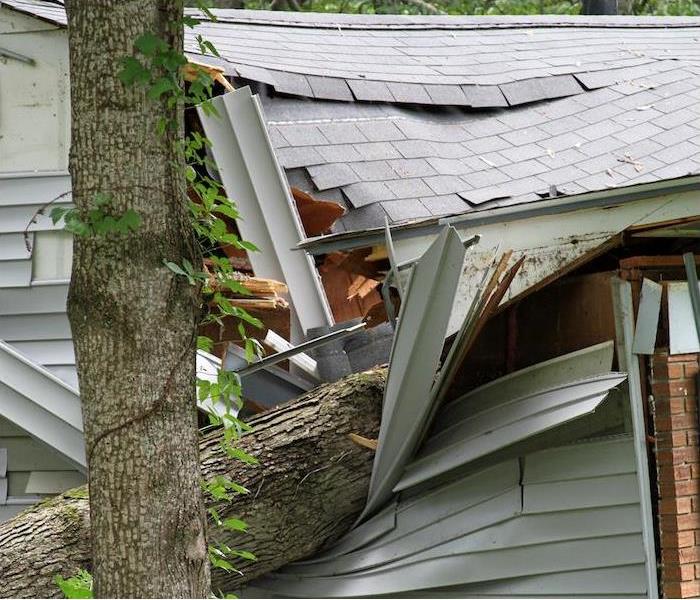 Don't delay! When storm damages affects your property, call SERVPRO.
Don't delay! When storm damages affects your property, call SERVPRO.
The weather in the fall can be both beautiful and unpredictable, with autumn colors giving way to powerful storms that can cause significant damage to homes and businesses. If you’ve experienced storm damage in your area, it’s important to act quickly and strategically to mitigate further issues and begin the recovery process.
Here’s a comprehensive guide to help you manage storm damage effectively.
Ensure Safety and Assess the Damage
- Following a storm, your immediate concern should be safety. Start by evaluating the exterior of your property. Look for visible damage such as broken windows, compromised roofing, or fallen trees. Exercise caution, as structures affected by storms can be unstable and dangerous.
- Before you enter your home or business, check for potential hazards. Be on the lookout for gas leaks or electrical issues. If you detect a gas leak or hear unusual sounds, evacuate the property and contact your gas provider immediately. For electrical problems, avoid using any appliances and reach out to a licensed electrician for a thorough inspection.
- Once it’s safe to proceed, document the damage meticulously. Take clear photographs and detailed notes of both interior and exterior damage. This documentation is essential for filing insurance claims and evaluating repair needs. Maintain a record of all interactions with insurance companies and contractors to streamline the claims process and ensure comprehensive restoration.
Contact Your Insurance Provider and Begin the Claims Process
- After assessing the damage and ensuring safety, the next critical step is to contact your insurance provider. Report the storm damage as soon as possible and provide them with the detailed documentation you’ve gathered. This will help initiate your insurance claim and facilitate the process of getting your property repaired.
- Your insurance provider will guide you through the claims process, which may include an adjuster visit to assess the damage. Be prepared to discuss the extent of the damage and any immediate repair needs. Keeping thorough records of all communications with your insurance company will help support your claim and ensure a smoother recovery.
- While waiting for the insurance adjuster, avoid making permanent repairs until they have evaluated the damage. However, you should take temporary measures to prevent further damage, such as covering broken windows with tarps or boarding them up. This helps protect your property from additional issues, such as water infiltration.
Seek Professional Restoration Services
In the aftermath of a storm, taking swift and informed action is essential to minimizing damage and ensuring a successful recovery. By assessing the damage, working with your insurance provider, and enlisting professional restoration services, you can navigate the recovery process more effectively and restore your property with confidence.
With your insurance claim in progress and temporary measures in place, it’s time to engage professional restoration services. At SERVPRO®, we specialize in storm damage restoration and are equipped to handle all aspects of the recovery process. Our team has the expertise and tools necessary to address water damage, mold growth, and structural repairs effectively.
Fall Home Preparation: Preventing Water Damage
9/3/2024 (Permalink)
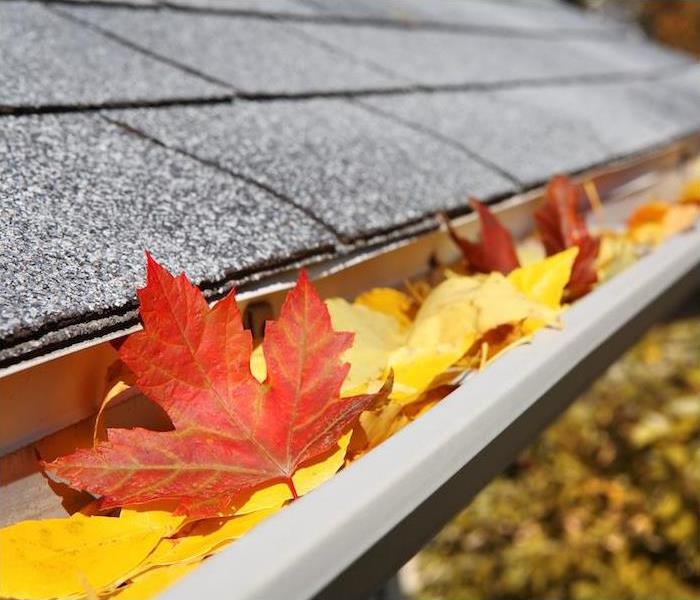 Safeguarding your home from water damage is easy this Fall with these insights.
Safeguarding your home from water damage is easy this Fall with these insights.
As the crisp fall weather settles over state, it’s crucial for homeowners in the area to prepare their homes for the upcoming season. With cooler temperatures and increased precipitation, taking proactive steps to prevent water damage is essential.
SERVPRO® Team Miller is here to provide you with expert advice to help safeguard your property this fall.
Keep Your Gutters and Downspouts Maintained
Fall brings an abundance of leaves and debris, which can easily clog your gutters and downspouts. When these drainage systems become obstructed, water can overflow and cause damage to your roof, siding, and foundation. To prevent such issues, it’s important to inspect and clean your gutters and downspouts before the peak of the fall foliage.
Ensuring that these systems are clear will help direct water away from your home’s foundation, reducing the risk of water damage and keeping your home protected throughout the season.
Inspect and Repair Your Roof and Siding
Fall weather can be tough on your home’s exterior. Heavy rains and gusty winds can exacerbate any existing damage to your roof and siding. Take the time to thoroughly inspect these areas for signs of wear and tear. Look for missing or damaged shingles and check for any cracks or gaps in your siding.
Addressing these issues promptly can help prevent water from seeping into your home and causing more significant damage. By making necessary repairs early, you can maintain the integrity of your home and avoid costly repairs down the line.
Protect Your Home from Freezing Temperatures and Frozen Pipes
Cold fall temperatures can lead to frozen pipes, which pose a serious risk of water damage. To protect your plumbing system, insulate pipes in unheated areas such as basements and crawl spaces. Ensure that garage doors remain closed, especially if there are water supply lines inside.
During particularly cold spells, let faucets drip slightly to keep water flowing and minimize the risk of freezing. Staying vigilant and taking these preventive measures will help safeguard your home from potential water damage caused by frozen pipes.
By following these fall maintenance tips, you can significantly reduce the risk of water damage and keep your home in excellent condition as the season changes. SERVPRO Team Miller is here to support you with expert advice and assistance for all your water damage concerns.
Preparing Your Commercial Property for Upcoming Season
8/15/2024 (Permalink)
 Preparing your commercial property for Fall is easy with these helpful tips and tricks!
Preparing your commercial property for Fall is easy with these helpful tips and tricks!
As autumn approaches, commercial property owners must prioritize preparations to protect their buildings from potential storm damage. Taking proactive steps now can mitigate risks and ensure your property remains secure and operational during adverse weather conditions typical of the fall season.
Roof and Exterior Maintenance
The integrity of your roof and exterior is crucial in defending against storm damage. Begin by inspecting the roof for signs of wear, such as loose shingles or areas prone to leaks. Promptly address any issues to prevent water intrusion during heavy rains or snowstorms.
Clear gutters and downspouts of debris to maintain proper drainage and prevent water buildup that could lead to roof leaks or foundation damage. Trim overhanging tree branches to minimize the risk of branches breaking off and causing damage during strong winds. Secure outdoor equipment, signage, and loose items that could become hazardous in severe weather conditions.
Windows, Doors, and Sealing
Examine windows and doors for gaps or cracks that may allow water infiltration or drafts. Seal these openings with weatherstripping or caulking to enhance energy efficiency and protect against water damage. Consider installing storm shutters or protective coverings for windows to reduce the risk of breakage from hail or strong winds.
Ensure exterior doors are equipped with sturdy locks and hinges to withstand high winds and prevent them from being blown open. Reinforce garage doors as needed to safeguard structures and items stored inside from potential damage.
Emergency Preparedness and Safety Measures
Preparing your commercial property for fall storms also involves planning for emergencies and ensuring the safety of occupants:
Review and update your emergency preparedness plan, including evacuation procedures, sheltering options, and communication protocols during severe weather events. Educate employees about emergency procedures and assign specific roles to ensure a coordinated response.
Inspect and test backup generators, sump pumps, and other critical equipment to ensure they are operational. Keep emergency supplies readily accessible, such as flashlights, batteries, first aid kits, and non-perishable food and water, in case of power outages or extended disruptions.
Stay informed about weather forecasts and storm warnings by monitoring updates from local authorities. Rapid changes in weather patterns in New Center and Highland Park during the fall months can lead to sudden storms, making it essential to stay vigilant and prepared.
Contact SERVPRO® Expert Assistance
For comprehensive cleaning and restoration services tailored to commercial properties, including storm damage restoration and emergency response planning, contact SERVPRO today. Our skilled team is dedicated to helping you safeguard your property and respond promptly to storm-related issues.
Urban Living and Fire Safety: Protecting Your Home During Summer
8/2/2024 (Permalink)
 SERVPRO is ready to help you have a fire-safe summer season with these helpful tips!
SERVPRO is ready to help you have a fire-safe summer season with these helpful tips!
Living in a city brings its own set of joys and challenges, especially when it comes to fire safety during the summer months. As you navigate urban life, it’s essential to prioritize fire safety to safeguard your home and community.
Here are some key tips to ensure a safe and enjoyable summer while living in a city.
Apartment Fire Safety: Prevention and Preparedness
- In densely populated urban areas, apartment buildings are common living spaces. Fire safety in apartments begins with prevention. Ensure smoke detectors are installed in every room and hallway and test them monthly to ensure they are functioning correctly. Know the location of fire exits and familiarize yourself with the building’s evacuation plan. Keep hallways and stairwells clear of obstructions that could impede evacuation in an emergency.
- When cooking, especially on hot summer days, avoid leaving the stove or oven unattended. Keep flammable items such as towels and curtains away from cooking appliances. If you use a grill on a balcony or rooftop, make sure it’s permitted by building regulations and keep it well away from any flammable materials.
City Parks and Public Spaces: Responsible Outdoor Activities
- City parks and public spaces are hubs of summer activity, from picnics to outdoor events. When enjoying these areas, be mindful of fire safety guidelines. Use designated grilling areas provided by parks and avoid setting up open fires outside of designated fire pits or areas. Dispose of hot coals and ashes properly by allowing them to cool completely before placing them in designated containers.
- During fireworks displays or events involving open flames, follow local regulations and guidelines strictly. Keep a safe distance from firework launch sites and never attempt to relight malfunctioning fireworks. After the event, ensure all debris is properly disposed of to prevent fire hazards.
Electrical Safety in Urban Homes
- City dwellings often rely heavily on electrical appliances and devices. To prevent electrical fires, inspect cords, plugs, and outlets regularly for signs of wear or damage. Avoid overloading outlets with multiple devices, especially during heat waves when electrical systems may be strained. Use surge protectors where necessary and never run cords under carpets or rugs where they can overheat and ignite.
- If you notice flickering lights, tripped circuit breakers, or a burning smell from electrical outlets, contact a licensed electrician immediately to investigate and resolve the issue.
Stay Safe with SERVPRO®
- As you enjoy the vibrancy of summer in the city, remember that fire safety is paramount for protecting yourself, your neighbors, and your community. By staying vigilant and following these tips, you can minimize the risk of fire hazards and ensure a safe and enjoyable summer season in urban settings.

 24/7 Emergency Service
24/7 Emergency Service









